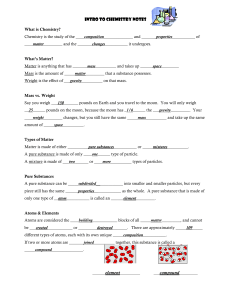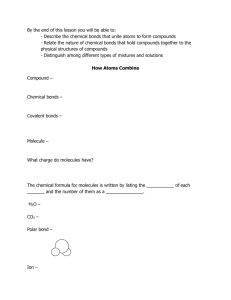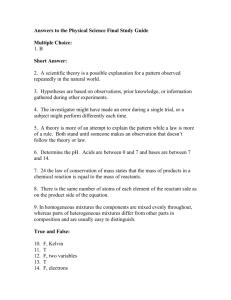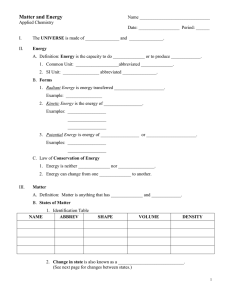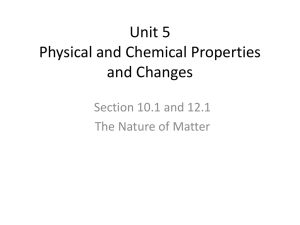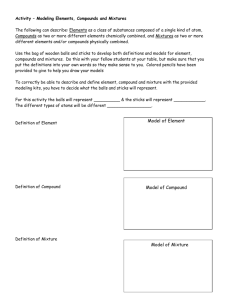Unit 5 Powerpoint
advertisement
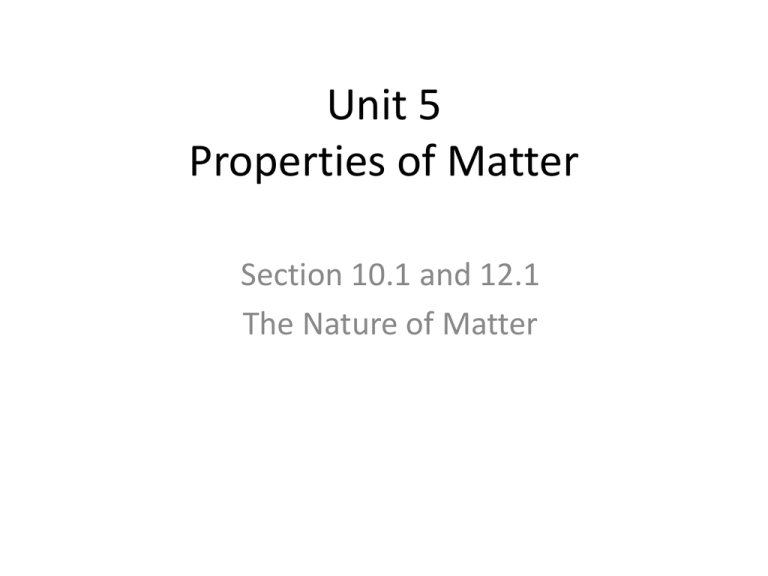
Unit 5 Properties of Matter Section 10.1 and 12.1 The Nature of Matter Level 3 Can identify chemical and physical properties of matter. And give examples of each. Can identify whether a change is either a chemical or physical change. Can distinguish between pure substances and mixtures. Can identify mixtures as either Homogeneous or Heterogeneous. Can, based on chem. formulas, identify a pure substance as either an element, compound or molecule. Can state whether a material has high or low values of the below properties: TERMS Lab: when given an object can determine its volume. Can determine the density of an object from the slope of a mass vs. volume graph. Can identify which term (accuracy, precision and resolution) applies to a given lab/measurement situation or example. Can give examples of objects that have a mass of 1gm, a volume of 1ml and a length of 1cm. • Density (D = m/v) Malleability Elasticity Hardness Odor Conductivity Tensile Strength Thermal Expansion Brittleness Viscosity Color • Matter – anything that has mass and volume • Matter is made of tiny particles called atoms. • Democritus and Leucippus– Greek Philosophers – 1st to use term atomos. • Brownian Motion – all atoms move in a jerky motion Matter Substance Can NOT be broken down by physical means. Element Compound Mixture SUBSTANCE • Element – Composed of atoms – Can NOT be broken down – Periodic Table • One capital letter • Compound – Composed of elements joined chemically – Two or more capital letters • Exception: Molecules – O2, H2 Matter Substance Mixture CAN be broken down by physical means. Homogeneous mixture Heterogeneous mixture MIXTURES • Homogeneous • Heterogeneous – A mixture that is the same throughout – Each sample is the same – A mixture in which the samples are not the same throughout. – Different proportions – Examples: – Examples: • • • • Salt water Rubbing alcohol Closed can of pop Air • Cup of sandy water • Water with ice cubes • Open can of pop Ways of Separating Mixtures • • • • • • Physical Means Sorting Filtering Heating / Evaporation Cooling Chromatography Magnetism Chemical Means • Electrolysis • Chemical reactions • Distillation Chemical and physical properties Matter • Every element/compound is unique in some way from all others. • If you know enough about a substance, you can figure out what it is. • If you know what a substance is, you can know all types of things about it. Matter • All matter has 2 types of properties: – Physical properties – chemical properties. Physical properties • A physical property is a characteristic of a substance that can be observed without changing the substance into another substance. – (You can see it without changing what you’re looking at into something else.) Physical Properties • Physical properties can be extensive or intensive: – Extensive properties depend on the amount of a substance that you have. – Intensive properties don’t depend on how much you have. Physical Properties - Examples • Examples of extensive physical properties include: – – – – Volume Mass Weight Size Physical Properties - Examples • Examples of intensive physical properties include: – Density – Melting point – Boiling point • Physical Properties - Examples Other physical properties include: – Color – Hardness – Odor – Taste – State of matter – Texture – Luster (shine) – Flexibility – Heat conductivity – Electrical conductivity – Solubility (ability to dissolve in water.) – Shape – Viscosity – Ductility – Malleability Chemical properties • A Chemical property is a characteristic of a substance that can only be observed by changing it into a different substance. Chemical properties - Examples • Examples of chemical properties include: – – – – – The ability to burn Ability to tarnish Ability to rust Ability to decompose Ability to react with other chemicals – Instability – Ability to do acid/base reactions Element abundance • The most common element in the universe is Hydrogen (about 75%), and Helium (about 25%). • The most common element on Earth is Oxygen (46.6%), and Silicon (27.7%). • The most common element in your body is Oxygen (65%), and Carbon (18%) Chemical and physical changes Physical Change • A Physical change is a change in a substance that does not change what the substance is. Physical Change - examples • Examples of physical change include: – Change in shape – Change in size – Change in phase • • • • • • • Melting (solid to liquid) Boiling (liquid to gas) Evaporation (liquid to gas) Condensation (gas to liquid) Freezing (liquid to solid) Sublimation (solid to gas) Deposition (gas to solid) Physical Change • Physical changes might be caused by: – – – – – – Grinding Cutting Crushing Bending Breaking Heating/cooling • (change in phase) – squishing Physical Change • Evidence that a physical change has occurred might include: – – – – Change in shape Change in form Change in size Change in phase (This is always a physical change!) – Physical changes are usually reversible Physical change • What could you do to these items to cause a physical change to occur? Chemical change • A chemical change is a change in which a substance is changed into a different substance. (You’ve changed what it is.) Chemical change • Examples of chemical changes include: – – – – – Burning Rusting Tarnishing Decomposing Polymerization Chemical change • Chemical changes occur when a chemical reaction causes bonds between atoms to break or to form. Chemical Change: Evidence • Evidence that a chemical change has occurred might include: – A color change – An odor change – Formation of a precipitate (you mix two liquids and make a solid) – Gas is formed (bubbles) – Changes in physical properties. Physical and Chemical change • During a chemical change energy can be released in the form of: – Heat – Light Chemical change – Chemical reactions • When a chemical change occurs, energy is either released or absorbed. Physical and Chemical change - heat • A chemical reaction that releases energy in the form of heat is called exothermic. – Heat comes OUT • Exo = out • Thermic = heat – It will feel HOT. Physical and Chemical change - heat • A chemical reaction that absorbs energy in the form of heat is called endothermic. – Heat goes IN • Endo = in • Thermic = heat – It will feel COLD

